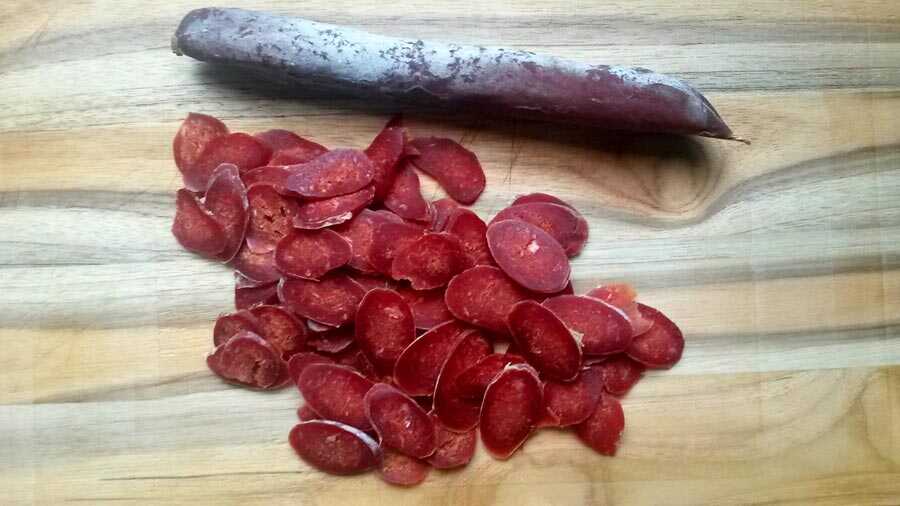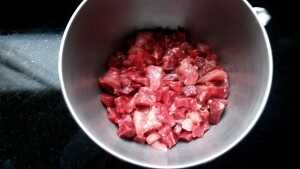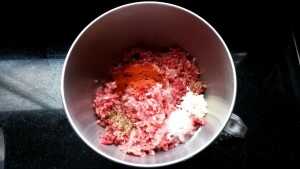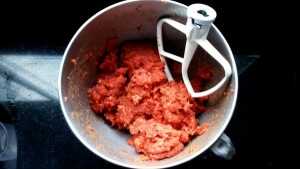
Pepperoni salami has a strong seasoning and is widely consumed, especially in the USA, due to its extensive use in the production of pizzas. Its original name is peperone (in free translation it means large pepper) and it dates back to Roman times. The original version is drier, hotter and more spicy than the contemporary commercial version. I applied a recipe here that is more focused on the original version.
Definition and commercial classification of Pepperoni
Pepperoni is an industrialized meat product, made with pork and/or beef, bacon, added ingredients, with an average particle size between 3 and 6 mm, embedded in natural or artificial wrappers, peppered, cured, fermented, matured, dried for the indicated time by the manufacturing process, smoked or not.
Homemade pepperoni recipe
Ingredients
- 1.2kg of lean beef;
- 1.2kg of pork;
- 40 grams of salt;
- 6 grams of curing salt 2 (6% of nitrite, 3% of nitrate and 93.75% of salt);
- 0.1g of starter culture (lactic acid bacteria);
- 60 ml of filtered water;
- 9 grams of cayenne pepper (can replace with other red pepper powder);
- 1 gram of allspice (can be replaced with black pepper);
- 40 grams of dextrose or common sugar;
- 2 grams of ground fennel;
- 20 grams of spicy paprika;
- 30 ml of red wine;
- Pork tripe or collagen casing.
Pepperoni preparation
Refrigerate, clean and cut the meat into cubes.
Grind all the meat with the fine disc of your grinder.
Add the salt and curing salt and mix quickly with the flat paddle of an orbital mixer or with another mixer of your choice (spoon and strong arm, for example).
Dissolve the starter culture in filtered water and add it along with the other ingredients to the ground meat.
Beat on low speed to incorporate all ingredients for approximately 2 minutes.
Stuff the mixture into pork or lamb casings, roll up 25 centimeters apart and secure the ends with string or a clamp. I used pork intestines and just rolled up the ends. Using a sterile pin or needle, pierce the casing to remove air pockets and facilitate drying.

Maturation and Drying of Pepperoni
Leave at room temperature, ideally 25 degrees, for 48 hours for the maturation/incubation process of the added bacteria to occur. Beneficial bacteria will grow and produce lactic acid at high temperatures, quickly increasing the acidity that will protect the product during the drying process.
For security reasons, I recommend reading the post about curing salt. In it you will find relevant information about healing, acidity and prevention against botulism.
Hang and let cure/dry at a temperature close to 12°C with 70% to 80% humidity until the pepperoni is firm. The right point is generally when the pepperoni loses around 35% of its initial weight, which should occur between 6 and 18 days, depending on the casing used. Lamb intestine is thinner and dries faster.
If the environment is too dry, the outermost part of the pepperoni will dry out too much and create a dark, hard “shell” that will prevent the interior from losing moisture. You probably won't lose the product, but the center will never dry properly, so always maintain good humidity.
I used a wine cellar with temperature control. The internal environment of the cellar remained with good humidity, but if you notice that it is dry, leave a bowl with water and plenty of salt (this will prevent mold) at the bottom of the drying area. If it is a large room, use a humidifier.
In the case of the wine cellar, the steel supports for the bottles are removable and the upper support was used to hang the pepperoni, in addition to having a fan that helps with air circulation.

Final result
Pepperoni is lean as it does not contain extra added fat. The flavor is quite spicy and the paprika is evident. During drying, white mold appeared, which I kept as it is the typical benign mold on artisanal sausages. If you prefer to remove it, rub a cloth with brine (50g of salt for 1 liter of water) whenever you notice it appearing.
Drying was not perfect, probably because the environment was a little less humid than ideal, and the crumb was a little less “ripe” than the outer part, but it did not compromise the flavor of the final product.









To mature Piperone, for those who do not have a wine cellar, is there another viable option?
Hello Alexandre. You can make it in the regular refrigerator like this homemade salami recipe Handmade salami made in the fridge
Good afternoon. I'm producing this recipe and it's already 8 days old.
She has already lost 15% of weight, mold has appeared (I didn't add mold) and the casing has also come loose. I forward the photo for you to see. What could have caused this phenomenon?
Thanks
Photo link: ?dl=0
?dl=0
Mold is very common and has 3 options: clean by rubbing water with salt and vinegar, apply mold culture or use an antifungal such as potassium sorbate. In this case, as it is already underway, the best option is to clean whenever mold appears. Regarding the detachment of the casing, it was most likely some contamination that proliferated inside this salami. I recommend that you discard this unit.
Thank you very much for the explanations. On the same day I made 3 different recipes, Cacciatore, Artisanal Salami and Peperoni. The Cacciatore and Artesanal didn't cause any problems with the casing coming off, but all the peperoni came off, without exception. The only different procedure for the peperoni was that I ended up forgetting to pierce the casing, piercing them after 2 days. When I pierced the casing it was still stuck together, with some bubbles and there was no sign of visible mold. I pierced the salami at night, the next morning they were all peeled off. Could this have been the cause of this detachment?
It was probably the holes that caused the casing to come off and perhaps they also carried some contamination that was on the surface. If you do not notice contamination, I recommend that you remove the collagen and apply another wrapper, it could be a collagen sheet or pork or beef intestine rolled up like a bandage, firmly secured so that it does not come loose again.
Good morning. I'm just stopping by to give feedback on the tips. ?dl=0
?dl=0
I did as suggested, cleaned it, removed the old casing and made a wrapper with collagen foil. I have no elastic net and no bandages to put on, so I made very tight ties with food string to help “glue” the collagen sheet. Since I put it on, it has dried a little and I can see greater adhesion of the collagen. He was even friendly.
Here's a link to the photo:
Thank you for the tips. Always willing to help!
Does charcutaria.org have Instagram? I would be happy to post and share the result, helping to promote the company/blog/art.
Strong hug!
Hi Dudu. I'm glad you managed to solve it, the lashing turned out really well! Then tell me if the process went correctly, if they were good. Follow our Instagram https://www.instagram.com/milenarcharcutaria/
Hello goodnight.
Moving on to show the result of a first production.
Photograph: ?dl=0
?dl=0
From left to right they are: cacciatore, colonial and pepperoni.
Address problems with humility and you can clearly see the case hardening in the photo, which left the middle very soft.
All had a loss of 36%.
I really liked the flavor of the Pepperoni and my wife loved the cacciatore. The colonial did not please. I don't know if due to the beef cut (which was breast) you can feel a little rancidity deep down.
But for a first production I'm very satisfied.
Thank you for the tips!
Hug!
Hi Dudu, thanks for sharing! For a first production, they were beautiful. As you get the hang of it, your productions will get better and better. You will learn to control the humidity in your chamber and gain more confidence. Over the next few months, let them lose 45% of weight to test how they become firmer. I prefer firmer salami. Salamis with beef cuts have a more intense flavor, 100% pork ones are generally more pleasing. Test the Finocchina salami, Its very tasty. If you have any questions, do not hesitate to ask. A big hug!
Good morning! Is it possible to use yakult in Pepperoni as a “starter culture”???
Thanks
Yes, it is possible to do so, fermented milk (yakult) will acidify and protect, but it will not add other benefits. I usually do it without fermenting with a little wine or use a good starter culture, with a variety of bacteria that brings several benefits. I've already used yakult but as it will only acidify, I think it's easier to use wine and skip the fermentation.
Eduardo good afternoon,
I am producing some salami and cups, and I would like to know if it is necessary to use Mold 600 or 800 in these products. In salami I have already used TSPX as a starter, the tops are being cured for later maturation. Can I have problems not using these products? what is the recommendation.
Hi Leandro, you can use a penicillium mold culture, but its use is optional, the only problem it may have is the proliferation of unwanted mold in the products, which will consequently have to be removed whenever it appears. Applying mold culture generally does not have this problem as the beneficial mold takes over the product, inhibiting the proliferation of other unwanted molds.
Eduardo good afternoon,
I am producing some salami and cups, and I would like to know if it is necessary to use Mold 600 or 800 in these products. In salami I have already used TSPX as a starter, the tops are being cured for later maturation. Can I have problems not using these products? what is the recommendation.
Hi Leandro, you can use a penicillium mold culture, but its use is optional, the only problem it may have is the proliferation of unwanted mold in the products, which will consequently have to be removed whenever it appears. Applying mold culture generally does not have this problem as the beneficial mold takes over the product, inhibiting the proliferation of other unwanted molds.
Good evening, first of all, I would like to congratulate you on your excellent work in disseminating knowledge and especially for your humility in sharing your experience with extreme care in the comments. Well, I want to use fabric to wrap the product (around the world fabric or bandage), would you approve it safely? What would be the advantages x disadvantages?
Hi Bruno, thank you! The fabric can work but I don't usually recommend it because the holes in the weave are spaces where mold tends to settle. If mold appears in the middle of the fabric loops, it will be difficult to notice at the beginning. So you need to be extra careful in this aspect, opening and checking from time to time, especially if you turn the fabric around the meat a lot.
In the case of yakult, what is the dosage for this recipe?
Hi Gouveia. For yakult there is no precise rule as it is an alternative to the starter culture. There is no study or standardization on use. I believe that half a bottle is enough.
Hello!
Would the use of an emulsifier in salami improve the alloy? If so, what would you recommend?
Thanks
Valdomiro. From my point of view, the emulsifier is more suitable for emulsified products (finely processed), such as sausages and mortadella, especially when low-cost animal proteins are used, such as mechanically separated meat. Just like the stabilizer, its function is to help with moisture retention and weight gain. For salami I don't recommend it. Work the salami dough well until it becomes very sticky, this is enough for a very compact dough. Hugs!
Dude, why do other salami recipes available at CAVA include powdered milk as an ingredient? Isn't it an emulsifier too? Why in recipes then?
Hi Ramon. Powdered milk is an emulsifier, which serves to help the product retain moisture. In the salami process there must be a loss of moisture, so for me it is contradictory to use something to retain moisture when you want to lose moisture. Powdered milk also has lactose, which is a food source for the starter culture, so it can be used in this sense.
So should powdered milk be used in the salami recipe? To feed the culture? Or is it better not to use salami?
Ramon, in my opinion, avoid powdered milk in salami. If using a starter culture, add sugar (common/sucrose or dextrose). If you DO NOT use a starter culture, avoid any type of sugar and skip the fermentation step. Salami should only be fermented when a starter culture is added.
I would like to know how to store pepperoni after it is ready and how long can I store it? Should I leave it in the casing with the mold that forms or remove it? Can I leave it at room temperature? Thanks
The best way to store is to remove the casing, vacuum pack and refrigerate. This way it should last 90 days or more. If you don't have the means to vacuum pack it, you can wrap it with two or three turns of PVC film. Without protection he will continue to lose weight and will become very dry. Outside the refrigerator in hot periods it can become rancid more quickly. Hugs!
Can you use granulated or brown sugar instead of dextrose?
Yes you can, no problem.
Very informative and timely, it helped a lot!! Thank you friend !!
I would like to know which meat culture would be most suitable for the recipe and if there is any option to purchase on the website?
Good morning!
Is the curing salt to be used #1 or #2?
Grateful
Curing salt 2
I would like to know if I could put the peperoni and salami in the smoker to speed up the process and how much time is needed to obtain the final result?
I would like to know if I can make peperoni and salami in the smoking process to speed up the manufacturing time
Yes, you can, but do you intend to finish it in the smoker or are you going to smoke it for a short time and then hang it to dry?
Firstly, congratulations on the website!
I would like to know if I can use 20mm cellulose casing for this recipe.
Hello Antonio. I can't tell you about cellulose casing because I've never done it and haven't read anything about it, I'll look into it. At first I recommend that you do it in COLLAGEN or NATURAL casing (pork or bovine). If I discover something about cellulose I will update the comment. Hugs!
I want to make pepperoni, but if I don't use Cultura Starter, will there be a problem?
Or would there be another product to use instead of Culture?
And can I add a little bacon?
Hi Sérgio, no problem, you can do it without the starter culture. Add a little more wine to ensure good acidity and, consequently, protection. An alternative to the starter culture is yakult, which is also a lactic acid bacteria. It's a controversial alternative as it's not a well-studied crop for this function, but I've already done it and it worked. Yes, you can add bacon. 40% pork, 40% beef and 20% bacon is a good proportion for those who want pepperoni with more fat.
Eduardo, good night.
Can any other product be used to replace meat culture? It seems to me that I've already seen you using Yakult in a salami recipe! Could this be the function of Yakult in the dough (meat)?
Hi Cyro, yes, yakult works as a substitute for meat culture. Both (culture and yakult) are lactic acid bacteria and their function is to consume the sugars present and in return generate lactic acid, acidifying and protecting the product. I used yakult in Finocchiona salami. I didn't measure the pH but I could feel during the curing and in the flavor that acidification had occurred.
Since my temperature and humidity control equipment hasn't arrived yet, I was wondering if you recommend wrapping the pepperoni in parchment paper, since I'm going to age it in the refrigerator.
Thank you for the usual support you have given us.
Hug.
Cyro, the baking paper will act as an additional barrier, reducing the intense loss of moisture in the refrigerator. In addition to baking paper, you can also wrap it in a tea towel or cheesecloth, which I consider an even better option as you can remove, wash and replace it as many times as you want during the process. Those who only have a refrigerator and want to start with some experiments can be an option, but always thinking about improving it by purchasing or adapting a space with temperature and humidity control. The big problem with parchment paper is that you'll only find out what's going on after you open it and remove all the paper. There is no way to visually monitor whether there is an infestation starting in the product. As a guarantee, use a little more salt than the recipes indicate and wine or another acidifier. But it's worth mentioning that I've never seen a study/thesis or traditional book that recommends this procedure! If anyone knows of a study on this, please share the information!
A big hug!
Got it, Eduardo. However, I have a question: I prepared the Mold-600 to apply on the product (already with casing!) today and in two more days. If after this I wrap it in baking paper, won't I be compromising the creation and proliferation of fungi, or does it form right under the packaging?
It will almost certainly multiply in the casing inside the package. Open after a week and see if the white coating has appeared. I have documentation from CHR Hansen about Mold-600, I transcribed it below. Follow this procedure and it will work.
Initial application: 20-24ºC for approximately 72 hours;
Moisture: Greater than 93% in the initial fermentation period, with moderate air circulation;
Usage
During the drying process the culture is effective in preventing the emergence of drought
kidney. Furthermore, during maturation, the mold promotes an increase in pH and a less
sourish flavor.
Dosage
25 g culture for 10 L water
Directions for use
One pouch of freeze-dried culture is mixed into 1-2 liters of tap water at
approximately 20°C(68°F) and equilibrated for 2 hours at room temperature. The
suspension is diluted in 10 liters of tap water and is then ready for use.
The mold is inoculated after the stuffing (and eventually acclimatization process),
either by dipping or spraying or showering. The spore suspension should be stirred
continuously to prevent settling of the spores, and the suspension should only be
used on day of preparation (danger of yeast contamination)
Good evening Eduardo,
I made the recipe without the culture and doubled the amount of wine. I filled the casings today and it had a very strong smell of wine. I would like to know if it is normal and the smell will remain in the product.
The wine smell will diminish as the product dries. Other smells should appear if there is any fermentation or fungus formation during the process. If mold appears, remove it by rubbing with a cloth dampened in brine to improve the smell. Then tell us how it turned out!
Good morning Eduardo!
The smell of wine reduced, giving way to a very acidic smell. I put it out to cure on 02/08 and on Sunday (4th day) mold started to appear (a thin layer and concentrated in some spots). I rubbed it with the brine and dried it but since then (2 days) a thin layer has been appearing every day and a small concentration in some spots. It's normal? Do you think I can keep the pepperonis until they are done drying and rubbing in the brine every day?
Good morning Clesley, the acidic smell is normal and acidification is positive to protect the product. It will last for a long time until it dries well. If the mold spots are white and smooth (without filaments) you can leave them without any problems. But if the mold is dark and/or has filaments/hairs, then it is a good idea to remove it. Every day I think it's excessive but you can repeat the cleaning every 3 days or so. If this mold is very persistent, I recommend that after this pepperoni you clean the entire environment well with bleach, dry well and spray an intentional Mold-type culture so that future products are colonized by this new beneficial colony.
Good morning,
Great recipe! Very well explained!
I want to start working in charcuterie, I would like some help. If I execute the recipe without using curing salt, is there a high risk of contamination of the meat by botulinum toxin?
I'm making a ham using just salt and lemon and I have this fear. Is there a high risk of contamination leaving the ham to cure for two weeks in the refrigerator?
Clesley, the risk always exists but it is very small. Cases of botulism are extremely rare, but they do exist. One of the barriers is acidification. In the case of pepperoni, use an extra dose of red wine to be on the safe side. To understand better, read the Botulism paragraph in the post about Curing salt.
Thank you very much Eduardo!
I'll try your recipe here and comment on the results later!
Congratulations on the blog! It encouraged me even more to start charcuterie!
I live in Rondônia, the ambient temperature remains around 30g during the day, at night 24 it would be difficult to manufacture it in regions like this
Without an environment with a lower temperature, it is difficult. At these temperatures you can think about sun-dried meat, beef jerky or dried meat, as they use higher concentrations of salt that provide more protection.
Goodnight
The culture I have is T-SPX, is it also used for pepperoni?
and does mold-600 need to be used?
Att.
Hi Lucas, T-SPX is a lactic acid bacteria for fermentation, so it will protect the product through acidification. Mold-600 serves to colonize beneficial mold abroad and reduce the chance of proliferation of harmful ones. The two products are complementary and both will provide specific protection. From my point of view, the most important is T-SPX because the mold can be removed by cleaning the product with a cloth dampened in brine.
But can I use T-SPX instead of meat culture? and can I also use regular sugar instead of dextrose?
Lucas, T-SPX is a lactic acid bacterial meat culture. Yes, you can use regular sugar.
thank you very much
Goodnight
The curing salt that is used is 1 or 2
Instacure type curing salt #2. For long cures, the ideal is to also have sodium nitrate.
Edward good morning
I made the peperoni yesterday and the temperature was g
Fermentation is on average 18 degrees as it is cold. Is there a problem? How can I solve it?
Good morning Lucas, there are no problems with fermentation at this temperature, it will happen anyway, it will just take a little longer. The higher temperature at the beginning helps to accelerate the initial fermentation of the intentional culture but is not something that will cause problems in the product. You can proceed normally according to the recipe. Good luck, then post a photo with the result. A big hug!
Is this cellar like a wine cellar?
Yes, it's a mini wine cellar.
Is there any way to do it without curing salt? Another question: Can you use meat that has been frozen to make salami?
You can do it without the curing salt, but I recommend adding a little more salt and wine (acidification). This way you will have stronger protection barriers.
Thank you very much friend, I will do it this afternoon. And regarding meat that has already been frozen, could you tell me if there is any problem with making salami with it? Some say it can't be done, others say there's no problem, but they would like technical information. Thank you one more time!
Rodrigo, the ideal is fresh from a known origin with correct slaughter and post-slaughter treatment, but I've already made it with frozen supermarket meat and it works. It just cannot be frozen and thawed more than once as the expansion and contraction of the internal water breaks the muscle tissue and degrades the binding capacity.
Thank you very much Eduardo. I made the salami and they were wonderful! I made a fried piece to try, the rest is drying out.
Thank you very much for the tips, especially about meat, as it is more difficult for people who live in the city to get fresh pork. Next time, I'll make some with frozen meat and test the results. A hug and success to you!
Hello! Congratulations on the article!
One question: can you replace the yeast with citric acid if the objective is just to increase the acidity? Or do these influence the final flavor a lot?
Thanks
They don't influence the flavor that much, you can replace it with citric acid or a larger dose of wine. If you have the means to measure, the ideal is to reach a pH less than or equal to 4.5.
In the smoker, after it reaches 65 degrees internally, how long will I leave it in the smoker??
After the product reaches 65 degrees internally, keep it at that temperature for about 15 minutes and it will be ready for consumption. You can stop the heat and remove it or leave it for longer if you want to let it dry more. It can also heat the interior up to 75 degrees and cool immediately.
Hi Eduardo, is it still ok about the pepperoni, even if I finish it in the smoker at 65 degrees internally, does it need to add the same amount of curing and culture salt?
If I want it with a little more fat, what should I do?
I'm waiting wladir
Wladir, in this case there is no need for culture. Curing salt is recommended because the smoker is conducive to the proliferation of the bacteria responsible for botulism. Regarding the fat, use a meat with more fat or add a little pork belly.
Hello friend, if I'm going to smoke, how should I do it?
You can smoke it for a short time and then dry it according to the instructions in the post. You can also hot smoke until the internal temperature reaches 65 degrees, remove, rinse in cold water and leave to dry at room temperature. If your smoker has temperature control, you can smoke it at 50 degrees until it dries well, then increase the temperature to 70 degrees until the inside of the product reaches 65 degrees for 15 minutes, remove it, rinse it in cold water and leave it to dry by hanging at room temperature. There are several methods, so you need to decide which one is best for your goals.
Hi Eduardo, thank you very much for your attention, if I smoke at how long following your tips, can I vacuum-pack it to consume or do I have to leave it for longer to dry?
If you opt for hot smoking and the inside of the product reaches 65 degrees for 15 minutes, you can vacuum pack it as the product will be cooked and ready for consumption!
Thank you very much Eduardo
Blz Eduardo
I made this recipe, fermented it and left it to dry
My next question, in 24 hours of drying it has already lost 2.5% of weight, is it very fast or is it average, are 500 gram pieces, 50 gauge collagen casing
As you said, the kernel wasn't very ripe, I'll dry it 35%
Temperature 11° humidity 70 to 80%
Wow, great website
Hi Fernando.
Raise the temperature to 16 or 17 degrees. At first the loss of moisture is greater, it's normal, then it becomes increasingly slower. If you find that the outside is drying out too quickly, increase the humidity for a few days to 85% and rub cooking oil with your hands just to moisturize the outer layer of the product a little. Good luck! Then tell us how the end result was.
Thank you very much Eduardo, I'll send you the results later.
?